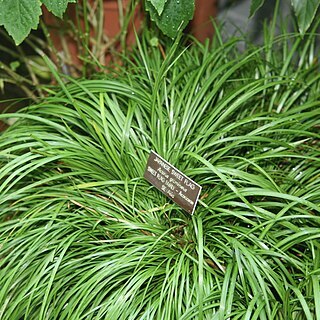Rhizome slender, 5-10 cm long, 0.4-0.6(-0.8) cm diam., aromatic. Leaves several, ensiform, dark to mid-green, (15-)20-45(-55) by (0.3-)0.5-1(-1.4) cm, apex acuminate, midrib lacking. Peduncle compressed-triangular, (4-)9-20(-24) cm long. Spathe leaf-like, green, (8-)10-24(-25) by 0.2-0.4(-0.5) cm. Spadix straight or slightly curved, narrowly cylindrical to subcylindrical, (3-)4-10(-14) cm long, (0.3-)0.4-0.6(-0.7) cm diam., densely flowered. Flowers perigoniate, yellowish, yellow-green to somewhat whitish, 1.8-2 mm diam. seen from above, tepals more or less oblong, keeled, rounded at apex or acute, membranous, 1.5-2 by 0.7-1 mm; filaments oblong, flat, c. 1.5 mm long, anthers 0.4-0.5 mm diam., yellow; pollen grains c. 15 μm long, exine more densely foveolate; gynoecium obconic-cylindric, (2-)2.5-3 mm long, (1.2-)1.8-2 mm diam., with conical, spongy apex and very small stigma. Infructescence yellowish to yellow-white at maturity, 1-1.5 cm diam., berries arranged densely, obovoid-globose, few-to several-seeded, 3-3.5 mm long, 2.2-2.5 mm diam.; seed ellipsoid, (2-)2.5-3 mm long, (0.8-)1-1.2 mm diam., with many long (3-4 mm) bristles (longer than seed itself), testa more or less smooth, light brown.
More
Rhizome slender, 5-10 × 0.4-0.6(-0.8) cm, aromatic. Leaves several, dark green, ensiform, (15-)20-45(-55) × (0.3-)0.5-1(-1.4) cm, midrib lacking, apex acuminate. Peduncle compressed triangular, (4-)9-20(-24) cm. Spathe green, leaflike, (8-)10-24(-25) × 0.2-0.4(-0.5) cm. Spadix straight or slightly curved, narrowly cylindric to subcylindric, (3-)4-10(-14) × (0.3-)0.4-0.6(-0.7) cm, densely flowered. Flowers yellowish or yellow-green to somewhat whitish, 1.8-2 mm in diam. seen from above; tepals ± oblong, 1.5-2 × 0.7-1 mm, keeled, membranous, apex rounded or acute; filaments oblong, flat, ca. 1.5 mm, anthers yellow, 0.4-0.5 mm in diam.; pollen grains ca. 15 µm, exine more densely foveolate; gynoecium obconic-cylindric, (2-)2.5-3 × (1.2-)1.8-2 mm, with conic, spongy apex and stigma very small. Infructescence yellowish to yellow-white at maturity, 1-1.5 cm in diam., berries densely arranged. Berry obovoid-globose, few to several seeded, 3-3.5 × 2.2-2.5 mm. Seed ellipsoid, (2-)2.5-3 × (0.8-)1-1.2 mm, with many long (3-4 mm) bristles (longer than seed itself); testa light brown, smooth. Fl. Feb-Jul, fr. Jul-Aug. 2n = 24.
A perennial herb 30 cm high and 15 cm wide. The leaves are linear and form short fans. It is smaller than sweet flag. The leaves are dark green with a grass like point. The leaves grow in 2 ranks or groups. These are about 20-30 cm high. The flower is very small. They are in spikes 5-10 cm long.
It is a temperate plant. It grows well in shallow water and ponds. It grows in wetlands. It needs a sunny position. It can grow in well watered garden beds. In China it grows on moist rocky stream banks below 2,600 m above sea level. It suits hardiness zones 5-10. In Sichuan and Yunnan.
More
Wet places by streams and around ponds in central and southern Japan. Dense forests, moist rocky stream banks, meadows; at elevations below 2,600 metres.
Wet places by streams and around ponds in central and southern Japan. Dense forests, moist rocky stream banks, meadows; at elevations below 2,600 metres.


